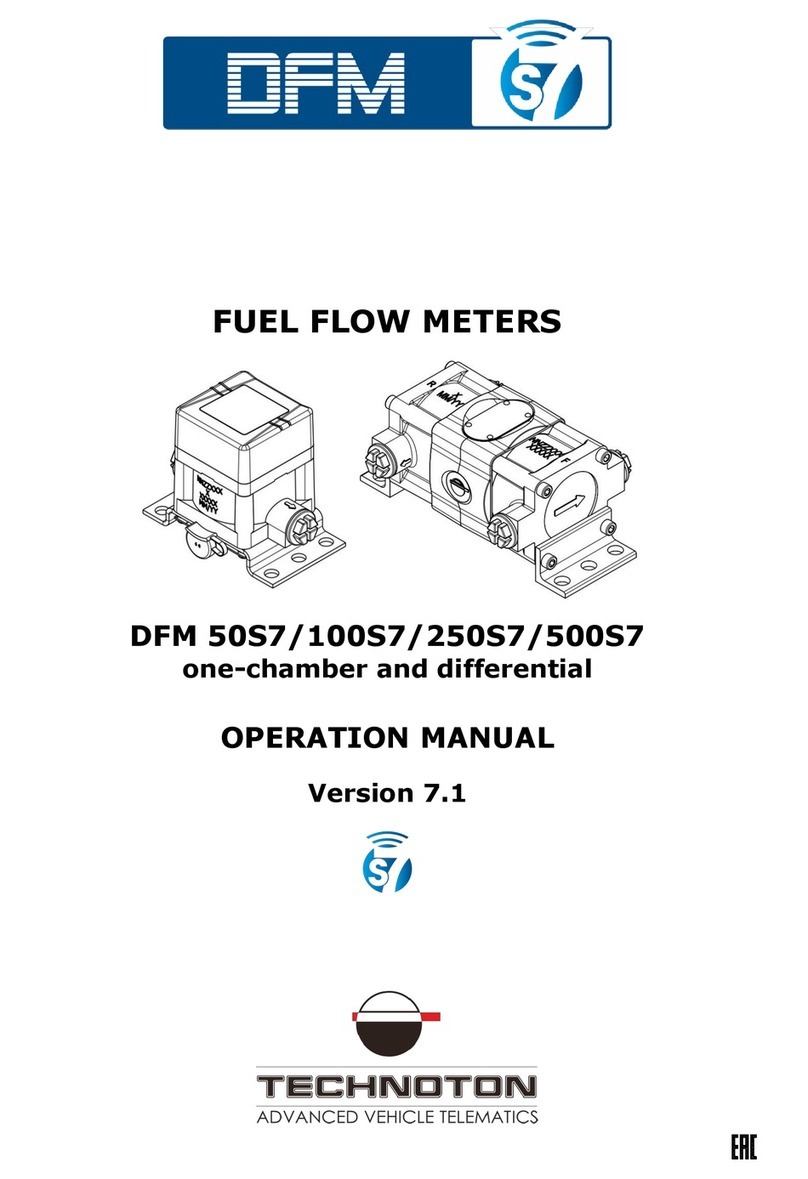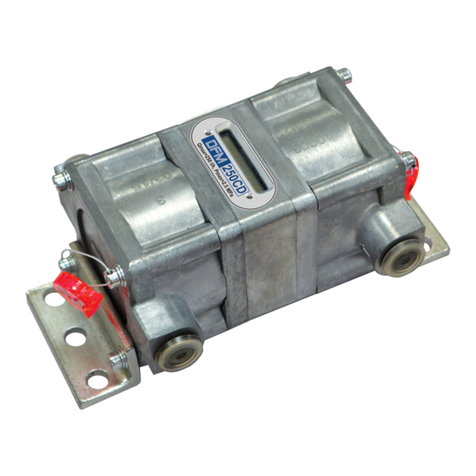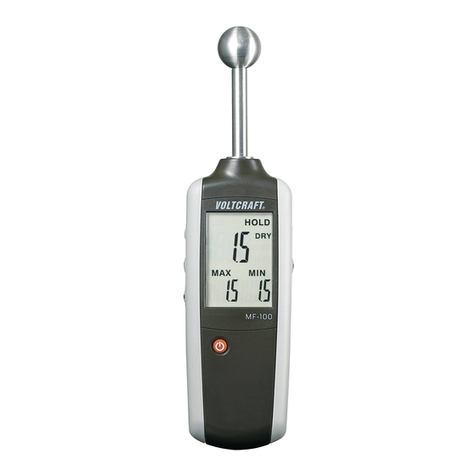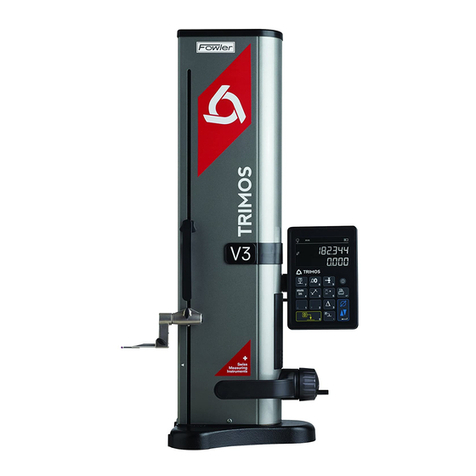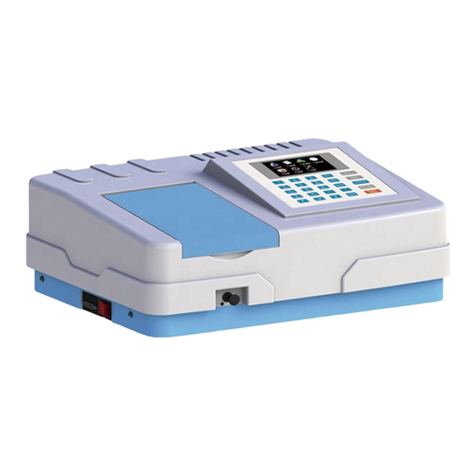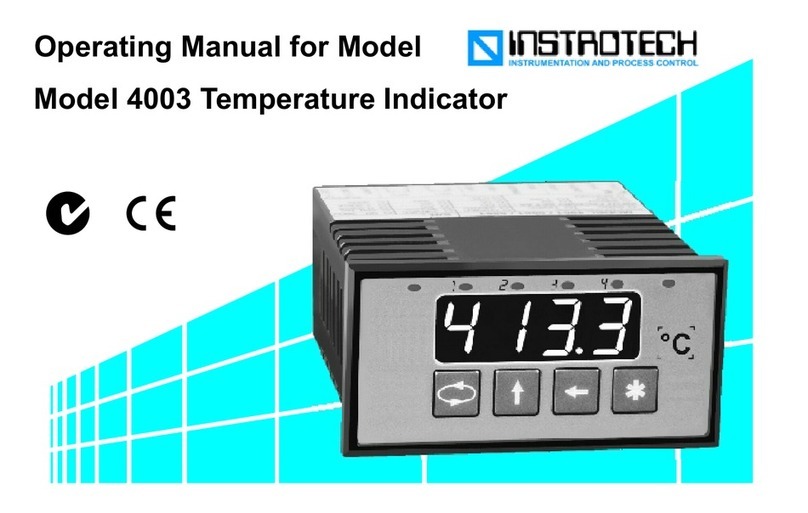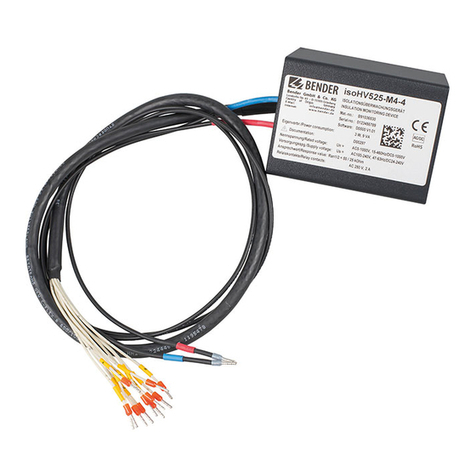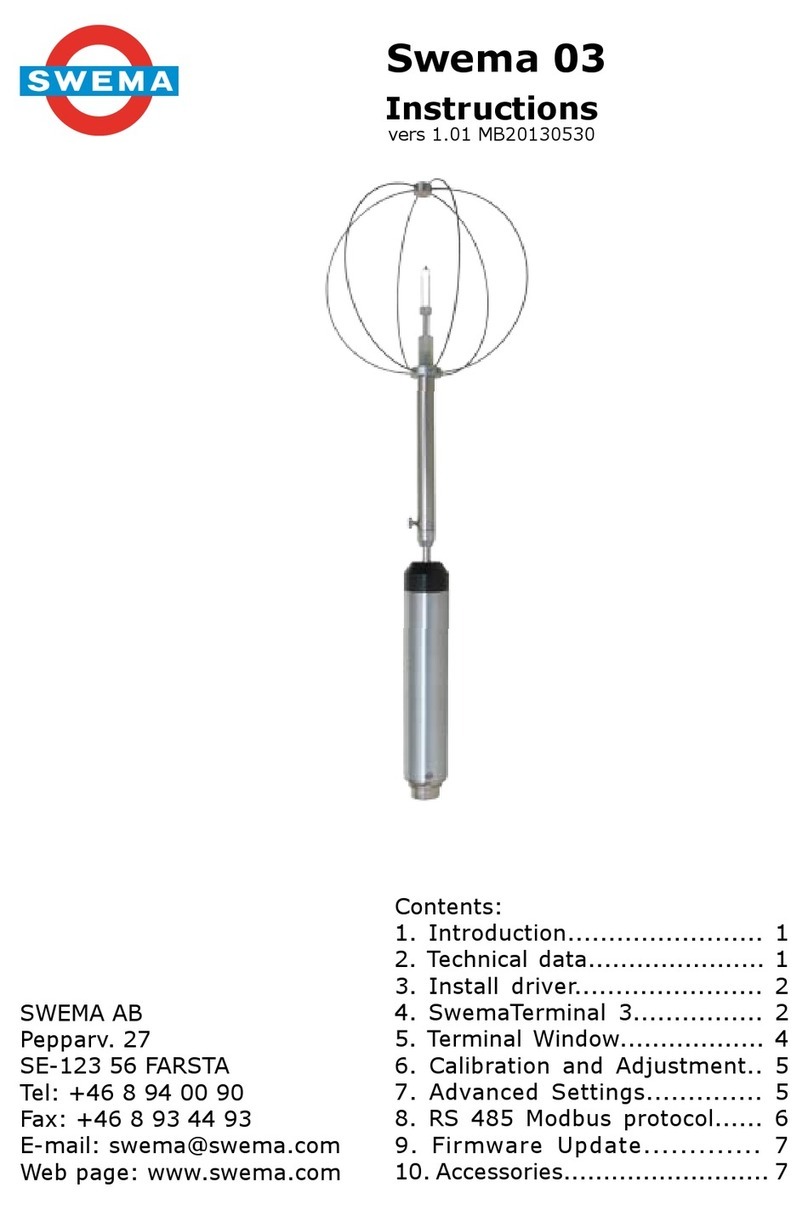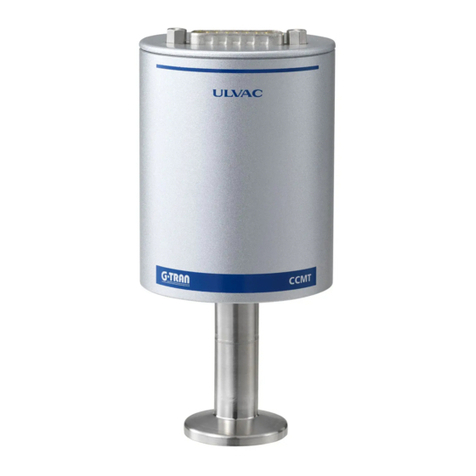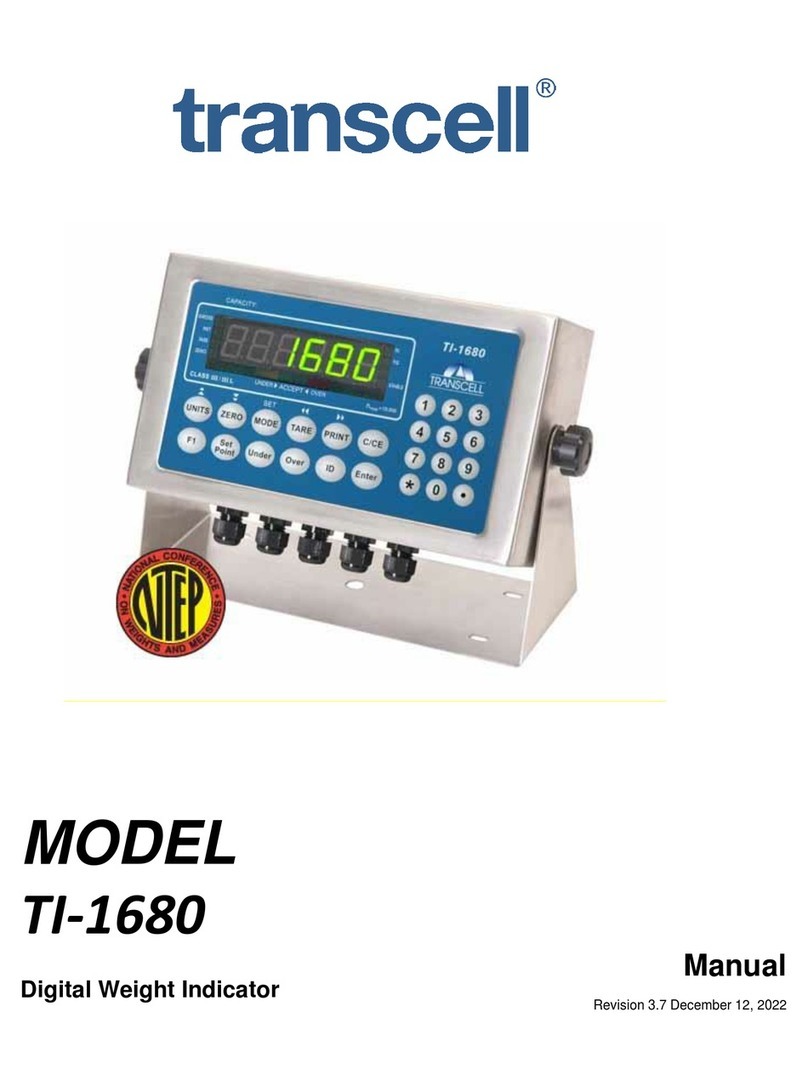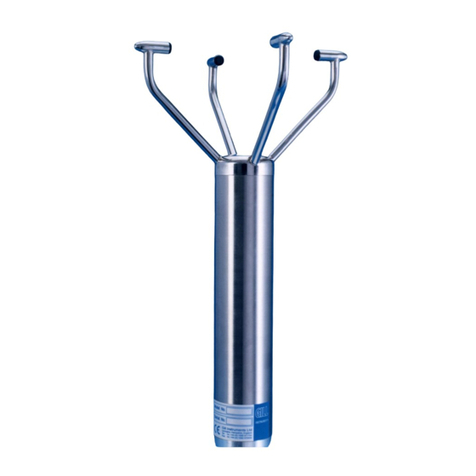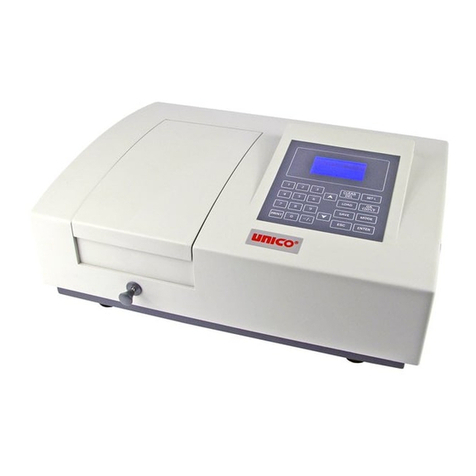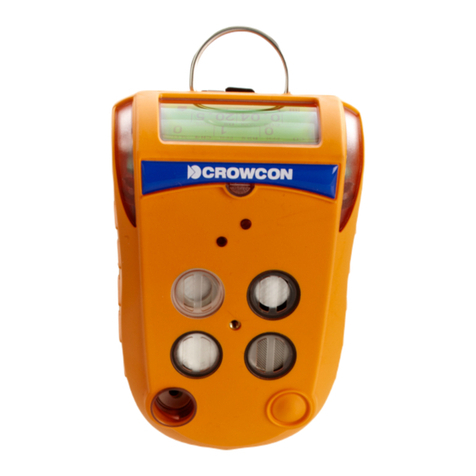Technoton DUT-E S7 User manual

Contents
DUT-E S7 fuel level sensor. Operation manual. Version 4.0
© Technoton, 2021 2
Contents
Contents ...................................................................................................................... 2
Revision history............................................................................................................. 4
Structure of external links .............................................................................................. 5
Terms and Definitions .................................................................................................... 6
Introduction.................................................................................................................. 8
1 General information and technical specifications of DUT-E S7 ......................................... 11
1.1 Purpose of use, operation principle and application area .......................................... 11
1.2 Exterior view and delivery set............................................................................... 13
1.3 Design ............................................................................................................... 14
1.4 Technical specifications........................................................................................ 15
1.4.1 Main specifications ........................................................................................ 15
1.4.2 Data composition of DUT-E S7 output message................................................. 16
1.4.3 Compatibility with receiving devices ................................................................ 18
1.4.4 Overall dimensions ........................................................................................ 19
2 DUT-E S7 installation ................................................................................................ 20
2.1 Exterior inspection prior to works start .................................................................. 20
2.2 Mounting ........................................................................................................... 21
2.3 Wireless transfer of sensor indications to the Android device .................................... 22
2.3.1 BLE-module activation ................................................................................... 22
2.3.2 Establishment of communication between the sensor and the Android device ....... 24
2.3.3 Interface of Fuel Tank Monitor application ........................................................ 26
2.3.4 Operations with the sensor Profile ................................................................... 27
2.3.5 Calibration of the measuring system ................................................................ 28
2.3.6 Calibration of fuel tank................................................................................... 30
2.3.7 Adaptation of indications for specific conditions of exploitation ............................ 33
2.3.8 Monitoring of indications using the Android device............................................. 37
2.3.9 Summation of indications ............................................................................... 39
3 Sealing .................................................................................................................... 41
4 Measurement accuracy check ..................................................................................... 42
4.1 Basic principles ................................................................................................... 42
4.2 Check tests procedure ......................................................................................... 43
5 Malfunction diagnostics.............................................................................................. 44
6 Maintenance............................................................................................................. 45
6.1 General instructions ............................................................................................ 45
6.2 Demounting ....................................................................................................... 46
6.3 Examination ....................................................................................................... 47
6.4 Cleaning ............................................................................................................ 48
7 DUT-E S7 Radiobox RS wireless interface..................................................................... 49
7.1 Purpose of use, operation principle, application area ............................................... 49
7.2 Delivery set........................................................................................................ 50
7.3 Design ............................................................................................................... 51
7.4 Technical specifications........................................................................................ 52
7.4.1 Main specifications ........................................................................................ 52
7.4.2 Output interface specifications ........................................................................ 53
7.4.3 Overall dimensions ........................................................................................ 54
7.5 Electrical connection............................................................................................ 55

Contents
DUT-E S7 fuel level sensor. Operation manual. Version 4.0
© Technoton, 2021 3
7.6 Configuration...................................................................................................... 57
7.6.1 Basic provisions ............................................................................................ 57
7.6.2 Connection parameters for
RS-232/RS-485
interface .......................................... 59
7.6.3 Establishment of communication with DUT-E S7 wireless sensors ........................ 60
7.6.4 Summarization of readings of DUT-E S7 wireless sensors ................................... 61
8 Packaging ................................................................................................................ 63
9 Storage ................................................................................................................... 64
10 Transportation ........................................................................................................ 65
11 Utilization/re-cycling................................................................................................ 66
Contacts..................................................................................................................... 67
Annex A Template of check test report ........................................................................... 68
Annex B Electromagnetic compatibility of BLE-module...................................................... 69
Annex C Explosion protection of DUT-E S7 ...................................................................... 70
Annex D SPN of
DUT-E S7 Radiobox RS
Functional modules ............................................... 71
D.1 Self-diagnostics FM ............................................................................................. 71
D.2 Fuel level sensor FM............................................................................................ 73
D.3 Fuel level control FM ........................................................................................... 75
D.4 Vehicle power supply FM...................................................................................... 76
D.5 Base S7 FM........................................................................................................ 78
Annex E DUT-E S7 Radiobox RS firmware upgrade .......................................................... 80
Annex F Videography ................................................................................................... 81

Revision history
DUT-E S7 fuel level sensor. Operation manual. Version 4.0
© Technoton, 2021 4
Revision history
Version
Date
Editor
Description of changes
1.0
01.2019
OD
Basic version.
1.1
03.2019
OD
Added information about the certificate of explosion protection of
sensor.
2.0
08.2019
OD
•Information on the new mobile application —Fuel Tank Monitor,
which is designed for displaying the sensor indications using
Android devices (instead of Service S7 DUT-E service mobile
application) is added.
•DUT-E S7 technical specifications and the delivery set are updated.
3.0
01.2020
OD
Information on DUT-E S7 Radiobox RS wireless interface and its
use together with DUT-E S7 wireless fuel level sensors is added.
4.0
02.2021
OD
Significant changes in the Fuel Tank Monitor mobile application
are reflected:
- new interface design;
- function of automatic defining the remaining distance of the route;
- function of summation of the fuel volume indications of
the specified group of sensors;
- function of selection between metric/USC systems of units of
measurement for data display;
- function of automatic defining the time left before the tank is full
during fuelling;
- separate configuration of functions of the Events detection:
“Fuelling”, “Discharging” and others.

Structure of external links
DUT-E S7 fuel level sensor. Operation manual. Version 4.0
© Technoton, 2021 5
Structure of external links
DUT-E S7 fuel level sensor. Operation manual
Document Center
S6 Website
Part S6 Data Base
Part S6 Functional modules
JV Technoton Website
Part Technical support
Part Software/Firmware
YouTube Technoton
ORF 4 Website
DUT-E/DUT-E 2Bio/DUT-E GSM.
Installation manual
CAN j1939/S6 Telematics interface.
Operation manual
Technoton Engineering Website
Page S7 Technology
Page GNOM S7
Page DUT-E 2Bio
Page CANUp
Page DFM S7
Page DUT-E S7
Page S6 Technology
ORF 5 Website

Terms and Definitions
DUT-E S7 fuel level sensor. Operation manual. Version 4.0
© Technoton, 2021 6
Terms and Definitions
S7 —Technology designed for wireless collection of data from unattended sensors in
systems of industrial and automobile Telematics. S7 Technology is recommended for
use in facilities where wiring is impossible or hard to install.
S7 Technology implements Bluetooth 4.X Low Energy (BLE) as a communication channel.
S7 Technology provides ultra-low power consumption and a long period of independent
operation for smart sensors and other IoT devices.
On the application level, S7 Technology is fully compatible with S6 Technology which uses
cabling.
Advantages of S7 Technology:
•Simple design of data transmission protocol;
•Low power consumption, a potential for fully independent operation of sensors for
several years;
•Option of data collection by several data recipients at one time.
DUT-E S7 fuel level sensor is based on S7 Technology.
S6 is the Technology of combining smart sensors and other IoT devices within one
wire network for monitoring of complex stationary and mobile objects: vehicles,
locomotives, smart homes, technological equipment etc. The Technology is based
and expands SAE J1939 automotive standards.
Information on cabling system, service adapter and S6 software refer to CAN j1939/S6
Operation manual.
PGN (Parameter Group Number) —is a combined group of S6 parameters, which has common
name and number. Functional modules (FM) of the Unit can have input/output PGNs and setup
PGNs.
SPN (Suspect Parameter Number) —informational unit of S6. Each SPN has determined
name, number, extension, data type and numerical value. The following types of SPN exist:
Parameters, Counters, Events. SPN can have a qualifier which allows qualification of
parameter’s value (e.g. – Onboard power supply limit/Minimum).
GNSS (Global Navigation Satellite System) —System for area positioning of an object through
satellite signal processing. GNSS is composed of space, ground and user segments. Currently,
there are several GNSSs: GPS (USA), GLONASS (Russia), Galileo (EU), BeiDou (China).
Onboard reports (the Reports) —information about vehicle which is returned to a user of
Telematics system in accordance with inputted criteria. The Reports are generated by a
terminal unit both periodically (Periodic reports) and on Event occurrence (Event report).
Parameter —time-varying or space characteristic of the Vehicle (SPN value). For example,
speed, fuel volume in the tank, hourly fuel consumption, coordinates. Parameter is usually
displayed in the form of graph, or averaged data.
Server (AVL Server) —hardware-software complex of Telematics service ORF 4 / ORF 5, used
for processing and storage of Operational data, formation and transmission of Analytical
reports through Internet by request of ORF 4 / ORF 5 users.

Terms and Definitions
DUT-E S7 fuel level sensor. Operation manual. Version 4.0
© Technoton, 2021 7
Event —a relatively rare and sudden change in SPN. For example, the sharp increase of
volume in the tank is the Event “Fuelling”. An Event may have one or more characteristics.
Thus, the Event “Fuelling”has the following characteristics: “volume of fuel at the beginning of
the fueling”, “volume of fuel at the end of the fueling”, “volume of the fueling” and so on. As
soon as an Event is detected, the Terminal registers the time of the Event which is
subsequently specified in the Report of the Event. The Event is always linked to the time and
the location where it was detected.
Counter —cumulative numerical characteristic of Parameter. Counter is displayed by a single
number and over time its value is increasing. Examples of counters: fuel consumption, trip,
engine hours counter etc.
Telematics terminal (Tracking device, Telematics unit) is a unit of Telematics system used
for reading the signals of Vehicle standard and additional sensors, getting location data and
transmitting the data to the Server.
Telematics system —complex solution for vehicle monitoring in real time and trip analysis.
The main monitored characteristics of the vehicle: Route, Fuel consumption, Working time,
technical integrity, Safety. In includes On-board report, Communication channels, Telematics
service ORF 4 / ORF 5.
Vehicle is an object controlled by the Vehicle Tracking System. This is generally a truck, a bus
or a tractor, sometimes a locomotive, a ship, a utility vehicle. From the point of view of Vehicle
Tracking System, static equipment such as diesel generators, heating boilers, burners, and so
on are considered vehicles.
Function module (FM) unit-embedded component of hardware and software combination,
executing a group of special functions. Uses input/output PGNs and settings PGNs.
Unit is an element of Vehicle on-board equipment compatible with S6 bus, which uses
S6 Technology or S7 Technology.

Introduction
DUT-E S7 fuel level sensor. Operation manual. Version 4.0
© Technoton, 2021 8
Introduction
Recommendations and guidelines contained in this Operation Manual are related to
DUT-E S7 fuel level sensor (further on —DUT-E S7), model code —07 manufactured by
JV Technoton, Minsk, Republic of Belarus.
Model code of DUT-E S7 is identified by third and fourth digits of its serial number
engraved at its measuring probe or printed on its packing label (see figure 1).
Figure 1 —Finding out model code of DUT-E S7
This document contains information on the design, principle of operation, specifications,
recommendations for operation of DUT-E S7.
—wireless sensor, used within Telematics system or autonomously,
for accurate level measurement of fuel and of other non-conductive liquids in vehicle
tanks and stationary storages (tanks).
DUT-E S7 key features:
•wireless transmission of data using S7 Technology via Bluetooth Low Energy channel
simultaneously to many receiving devices (Android-based smartphones/tablets, the
Telematics terminal, the display in the driver’s cabin);
•operation in the “advertising”mode (BLE-radio) —continuous transmission of
measurement results, with no need of integration with receiving devices;
•ultra-low power consumption provides completely independent sensor operation during
up to 5 years from the inbuilt battery, without the external power supply;
•availability of Explosion protection certificate —safe sensor operation in explosion-
dangerous environments;
•no signal cable–quick installation without a need of electrical connection;
•no signal cable —explosive and fire safety of the sensor is ensured without using
additional modules of explosion protection;
•no signal cable –increase resistance to sabotage;
•function of digital self-diagnostics for sensor quality control;
•automatic compensation of ambient temperatures effect on the electronic
sensor module.

Introduction
DUT-E S7 fuel level sensor. Operation manual. Version 4.0
© Technoton, 2021 9
DUT-E S7 has all the advantages of “classical” DUT-E fuel level sensor models:
•shortening/extending length of measuring probe;
•full set of mounting accessories and connection cable included;
•ergonomic bayonet mount allows to save installation time;
•bottom spring for better mounting rigidity;
•screen filter** for secure protection from water and mud;
•sealing possibility to avoid unauthorized intrusion and tampering;
•ergonomic grooves in body allow comfortable grip of sensor’s “head” when fastening it
in bayonet mounting plate;
•high-quality technical support and documentation;
•conformity with European and national automotive standards.
See figure 2 for identification codes for DUT-E S7 ordering.
Figure 2 —DUT-E S7 order identification codes
Example of DUT-E S7 ordering identification codes:
“Fuel level sensor DUT-E S7 L = 1000 mm”
(wireless S7 interface, measuring probe length 1000 mm)
.
*Can be manufactured with any custom measuring probe length up to 1400 mm.
**Not included into the delivery set.

Introduction
DUT-E S7 fuel level sensor. Operation manual. Version 4.0
© Technoton, 2021 10
To receive the sensor indications by means of S7 Technology with a smartphone/tablet based
on Android 5.X and higher operating system (further on —Android device),
Fuel Tank Monitor mobile application is used, its functionality enables the user to:
•Monitor current values of:
- fuel level in the tank;
- volume of fuel in the tank;
- frequency of the sensor measuring generator;
- temperature of fuel in the tank.
•Receive messages of recorded Events:
- “Fuelling”/“Fuel discharge”;
- “Low level of fuel in the tank”;
- “High/Low temperature of fuel in the tank”.
•Conduct the calibration of the measuring system and the fuel tank calibration.
•Enable/disable the feature of compensation of thermal expansion/compression of fuel in
the tank.
•Define automatically the remaining distance of the route, depending on the average fuel
consumption and the volume of fuel in the tank.
•Sum up indications of the fuel volume of the specified group of sensors.
•Define automatically the time left before the tank is filled during the fuelling operation.
•Monitor the received signal strength indicator (RSSI) and the time of the latest
message reception from the sensor.
•Monitor the current mode of the sensor operation.
•Monitor the sensor malfunctions.
•Receive the sensor ID data (serial number, firmware version, MAC address of
BLE-module).
•Record (log) current values of the measuring generator frequency, fuel temperature,
fuel level in the tank.
•Select between the metric system and the USC, to display sensor indications.
•Conduct operations with the sensor profile.
The user may download the Fuel Tank Monitor application from Google Play (search request
“Technoton”) and subscribe to it with 10 days free test period.
ATTENTION: It is strongly recommended to follow strictly the instructions of the
present Manual when using, mounting or maintaining DUT-E S7.
The Manufacturer guarantees DUT-E S7 compliance with the requirements of technical
regulations subject to the conditions of storage, transportation and operation set out in this
Manual.
ATTENTION: Manufacturer reserves the right to modify DUT-E S7 specifications that
do not lead to a deterioration of the consumer qualities without prior customer notice.

General information and technical specifications of
DUT-E S7 / Purpose of use, operation principle and application area
DUT-E S7 fuel level sensor. Operation manual. Version 4.0
© Technoton, 2021 11
1 General information and technical specifications
of DUT-E S7
1.1 Purpose of use, operation principle and application area
is used for:
•accurate level and volume (remaining) measurement in fuel tanks of vehicles and
stationary units (see figure 3);
•measurement of current fuel temperature in the tank;
•wireless transfer of data using S7 Technology.
Figure 3 —Purpose of DUT-E S7
Operating principle: DUT-E S7 has an inbuilt Bluetooth low energy module (BLE-module)
which, due to a special data transmission algorithm, enables the sensor operation with ultra-
low power consumption. The BLE-module transmitter switches on automatically once in 5 s to
transmit the current indications. Such a mode of operation enables the sensor to operate
completely independently during no less than 5 years without using any external power
sources; power is supplied only from the inbuilt battery.
Data from DUT-E S7 can be received at a distance of up to 50 meters by unlimited number of
various receiving devices (Telematics units, Android-smartphones/tablets etc.), which are
equipped with Bluetooth 4.X module.
Application areas: DUT-E S7 may be applied both independently, and within the Telematics
system (it may operate without using services of a Server) for wireless monitoring the fuel
volume:
1) In fuel tank of any Vehicle (see figure 4 a).
2) In fixed tanks (employed in oil products storage facilities, boiler equipment, diesel
generators sets etc.) (see figure 4 b).

General information and technical specifications of
DUT-E S7 / Purpose of use, operation principle and application area
DUT-E S7 fuel level sensor. Operation manual. Version 4.0
© Technoton, 2021 12
a) example of fuel volume monitoring in Vehicles tanks
b) example of fuel volume monitoring in fixed tanks
Figure 4 —Application areas of DUT-E S7
Due to the availability of the inbuilt BLE-module in DUT-E S7, up to 8 wireless fuel level
sensors can operate using S7 Technology together with CANUp 27 Pro Telematics gateway;
this enables to monitor in real time:
•accurate current value of fuel level and fuel volume in tank;
•accurate volume of fuel fill-ups and drains;
•fuel temperature;
•sensor specification data (passport);
•sensor malfunctions.

General information and technical specifications of DUT-E S7 / Exterior view and delivery set
DUT-E S7 fuel level sensor. Operation manual. Version 4.0
© Technoton, 2021 13
1.2 Exterior view and delivery set
1DUT-E S7 fuel level sensor –1 pc.;
2Specification –1 pc.;
3Magnetic key –1 pc.;
4Mounting kit (1 pc.) including:
a) bottom stop –1 pc.;
b) plastic mounting plate –1 pc.;
c) rubber gasket –2 pcs.*;
d) sealing rubber ring –2 pcs.*;
e) bolt –5 pcs.;
f) threaded rivet –5 pcs.;
g) self-tapping screw –5 pcs.;
h) plastic seal ** –2 pcs.*;
i) sealing cord –2 pcs.;
j) pattern of mounting holes location –1 pc.
Figure 5 —DUT-E S7 delivery set
*1 pc. is for initial DUT-E S7 mounting and 1 pc. as a spare part.
The delivery set may include just 1 gasket of 4 mm.
** Exterior of seal can be different.
4 a
4 b
2
1
4 c
4 d
4 e
4 f
4 g
4 h
4 i
4 j
3

General information and technical specifications of DUT-E S7
/ Design
DUT-E S7 fuel level sensor. Operation manual. Version 4.0
© Technoton, 2021 14
1.3 Design
Figure 6 —Structure of DUT-E S7
Inside measuring “head” of sensor (1): electronic measuring unit, BLE module for wireless
data transfer using S7 Technology and built-in battery (see figure 6).
Measuring part (2) of the sensor composed of two coaxial tubes that form condensate coating.
Changes of sensor electrical capacity depend on the diving depth of measuring probe into fuel
(dielectric liquid according to its properties).
WARNING: Capacitive principle ensures highest accuracy of liquid measurement
when the liquid has constant dielectric permeability coefficient. Otherwise,
additional inaccuracy of measurement may appear.
1
2

General information and technical specifications of DUT-E S7 / Technical specifications / Main specifications
DUT-E S7 fuel level sensor. Operation manual. Version 4.0
© Technoton, 2021 15
1.4 Technical specifications
Powered of DUT-E S7 only by the built-in battery.
DUT-E S7 can be used in the conditions of temperate and cold climate.
For resistance to mechanical impact DUT-E S7 is shake and shockproof.
1.4.1 Main specifications
Table 1 —DUT-E S7 main specifications
Parameter, measuring unit
Value
Fuel level sensor operating principle
Capacitive
Sensor sensitivity to fuel level changes, mm
0.1
Relative measuring error (to the length of the
measuring part), %, not more than
±1.0
Wireless data transfer interface
Bluetooth 4.1
Transmitter power (Tx Power), dBm
+4
Maximum distance between sensor and receiving
device, m
20
(if mounted on a Vehicle or in indoor locations)
50
(when mounted within line-of-sight range)
Data transfer interval, s
5
Estimated lifetime of the sensor (battery life),
years
5
Maximum cutting of the measuring probe
up to any length required
Maximum length extension of the measuring
probe, mm, not more
3000*
Temperature range, °C
-30…+80
Ingress protection rating
IP55/57
Certificates of BLE module
electromagnetic compatibility
CE
FCC and IC (see annex B),
TELEC
BQE
Explosion safety certificate
(see annex C)
Weight, kg, not more than
1.0 (at L=1000 mm)
0.9 (at L=700 mm)
Overall dimensions, mm, not more than
see figure 8
*In case you need the measuring probe of extended length up to 6000 mm,
it can be manufactured upon order

General information and technical specifications of DUT-E S7 / Technical specifications / Data composition of DUT-E S7 output message
DUT-E S7 fuel level sensor. Operation manual. Version 4.0
© Technoton, 2021 16
1.4.2 Data composition of DUT-E S7 output message
DUT-E S7 wireless fuel level sensor transmits data by means of S7 Technology, without
integration with receiving devices and without acknowledgement of data reception.
The data in the form of Advertising packets are transmitted automatically with 5 s periodicity
in the continuous data transfer mode. The structure of the data packet transmitted by
DUT-E S7 is provided in figure 7.
Service field (AD0)
(permanent values)
Data field (AD1)
(variable values)
Data length
(AD Length)
(1 byte)
Data type
(AD Type)
(1 byte)
Data
(Data)
(1 byte)
Data length
(AD Length)
(1 byte)
Data type
(AD Type)
(1 byte)
Company
identifier
(Company ID)
(2 bytes)
Unit firmware
version
(Soft Ver)
(1 byte)
PGN
number
(PGN)
(2 bytes)
PGN data
(PGN Data)
(0…21 bytes)
0x02
0x01
0x06
0xXX
0xFF
0xFFFF
0xXX
0xXXXX
…
Figure 7 —Structure of data packet transmitted by DUT-E S7
The application layer of the output message protocol of DUT-E S7 conforms with S6 Database
(see table 2)
Table 2 —Data composition of DUT-E S7 output message
Field
number
Length
Parameter
Name
Fuel Level Sensor. RAW Data PGN 63277 (0xF72D)
1
4 bytes
SPN 521440
Frequency, Hz
2
1 byte
SPN 521457
Temperature, °C
3
2 bytes
SPN 5347*
Lateral acceleration extended range, m/s2
4
2 bytes
SPN 5348*
Longitudinal acceleration extended range, m/s2
5
2 bytes
SPN 5349*
Vertical acceleration extended range, m/s2
6
4 bytes
SPN 521488
Unit DTCs mask (see table 3)
8
6 bytes
-
Reserve
*In the process of preparation for introduction.
Table 3 —Numerical values of malfunction mask (DTCs Mask) of DUT-E S7
Numerical
value
Description of malfunction
1
Fuel temperature. No data or incorrect data
64
Current frequency of sensor’s measuring generator is higher by more than
100 Hz, compared to the stored value obtained during the calibration of the
sensor’s “minimum”
512
Defective measuring generator. Possible locking of the measuring module pipes
1024
Low battery charge (<10 %)
2097152
Real time clock. Clocking is off

General information and technical specifications of DUT-E S7 / Technical specifications / Data composition of DUT-E S7 output message
DUT-E S7 fuel level sensor. Operation manual. Version 4.0
© Technoton, 2021 17
SPN values of the sensor output message may be calculated according to the formula (1) using
attributes from table 4.
Parameter value = SPN Content ∙ Factor (Resolution) + Offset (1)
Table 4 —Attributes for calculation of current values of DUT-E S7 parameters
Parameter
Factor (Resolution)
Offset
SPN 521440
0.001
0 Hz
SPN 521457
1
-50 °C
SPN 5347
0.01
-320 m/s²
SPN 5348
0.01
-320 m/s²
SPN 5349
0.01
-320 m/s²
The fuel level value (Lact) may be calculated according to the formula (G.2):
Lact = Ls ∙F1∙(F0/Fact-1)/(F0-F1), mm (2)
where Ls–length of the sensor measuring probe after cutting, mm;
F0–frequency of the dry sensor measuring generator, Hz;
F1–measuring generator frequency of the sensor fully plunged into the fuel, Hz;
Fact –current value of the sensor measuring generator frequency, Hz.

General information and technical specifications of DUT-E S7 / Technical specifications / Compatibility with receiving devices
DUT-E S7 fuel level sensor. Operation manual. Version 4.0
© Technoton, 2021 18
1.4.3 Compatibility with receiving devices
DUT-E S7 can be used with receiving device (Android smartphones/tablets, Telematics units,
GPS tracker and other devices for data receiving, logging and displaying), which have
Bluetooth 4.X and high.
Recommendations on wireless connection of DUT-E S7 to Telematics terminals can be obtained
RECOMMENDATION: The best compatibility with DUT-E S7 sensor during its
operation using S7 Technology is provided by CANUp 27 Pro 3G/
CANUp 27 Pro Wi-Fi Telematics gateway. The procedure for connection of wireless
Units to the Gateway please, see in CANUp 27 Operation Manual.

General information and technical specifications of DUT-E S7 / Technical specifications / Overall dimensions
DUT-E S7 fuel level sensor. Operation manual. Version 4.0
© Technoton, 2021 19
1.4.4 Overall dimensions
Figure 8 —DUT-E S7 overall dimensions
*Nominal measuring probe length (700 mm/1000 mm).

DUT-E S7 installation / Exterior inspection prior to works start
DUT-E S7 fuel level sensor. Operation manual. Version 4.0
© Technoton, 2021 20
2 DUT-E S7 installation
For DUT-E S7 correct operation its mounting and configuration should be carried out by
certified specialists who have passed corporate technical training.
ATTENTION: Strictly follow safety rules of automobile repair works as well as local
safety rules of the customer company when mounting sensor.
2.1 Exterior inspection prior to works start
It is necessary to conduct DUT-E S7 exterior inspection for the presence of the possible defects
arisen during transportation, storage or careless use.
Contact the product supplier if there any defects.
Table of contents
Other Technoton Measuring Instrument manuals

